Photos from the Field: Ospreys Nest on Abandoned Crab Pot
Life is precious.
by Ben Wurst, Habitat Program Manager

by Ben Wurst, Habitat Program Manager

by Ben Wurst, Habitat Program Manager
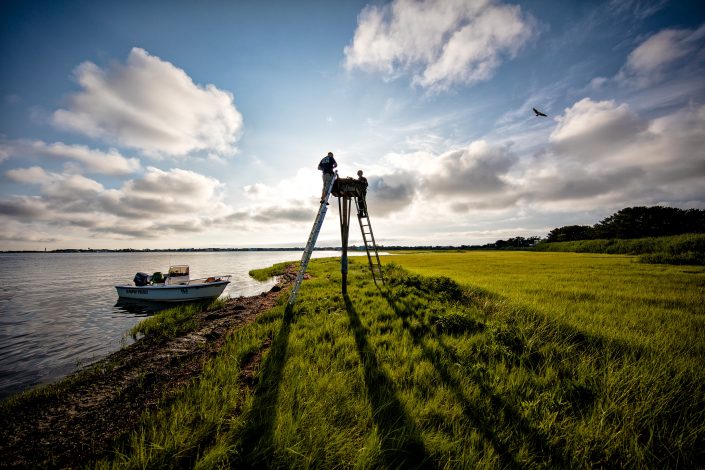
Ospreys are living barometers. They symbolize the resilience of life along the New Jersey coast. As a top tier predator who feeds exclusively on fish, their collective health is a direct link to the health of our coastal waters. Anyone can tell you that a healthy coast is essential to life at the shore. Clean water with abundant and healthy wildlife equals a booming shore economy. We have all benefited from actions and policy that have protected our air, land and water since the 1970s. Ospreys are no exception.
Continue reading “New Jersey’s Ospreys: A Symbol of a Healthy Coast ~ Part III”CWF Volunteers Are Wildlife Heroes
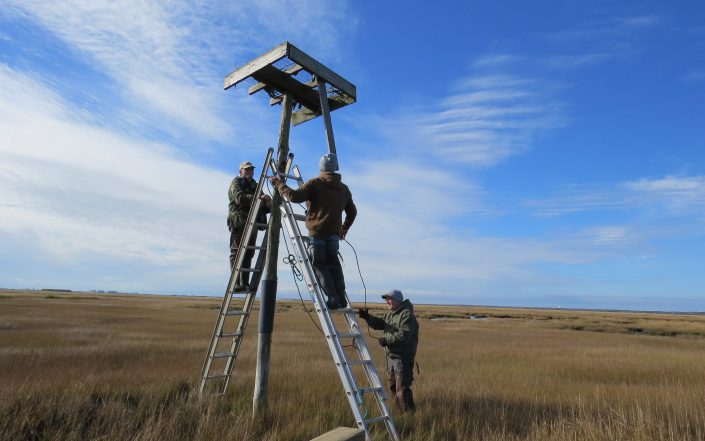
New Jersey ospreys have headed for warmer climates until their return in the spring. NJ osprey project volunteers are busy repairing and cleaning out nests, adding predator guards and perches in preparation for the nesting season. It’s an endless job as there are 100’s of nesting platforms throughout the state and maintenance is always needed. These repairs keep the nests as safe as possible for the nesting ospreys.
Thank you to all the dedicated CWF volunteers!

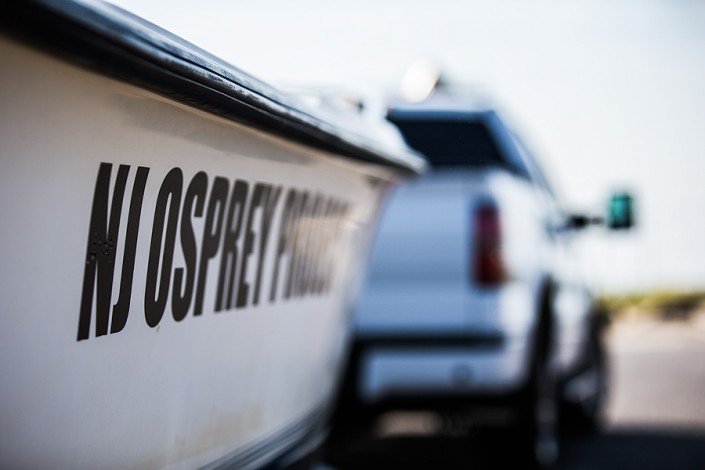


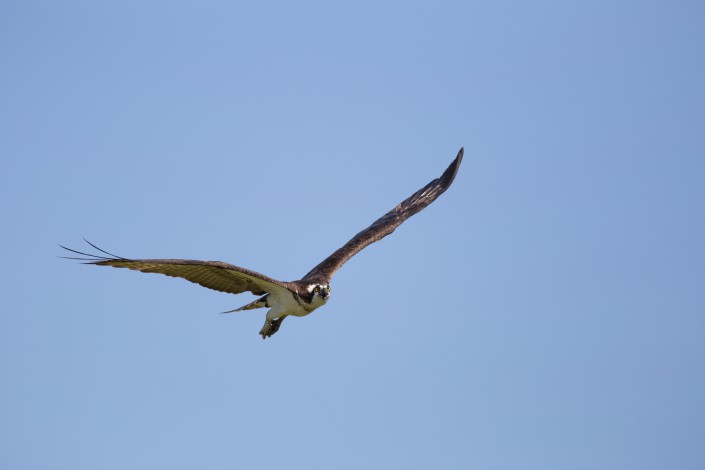
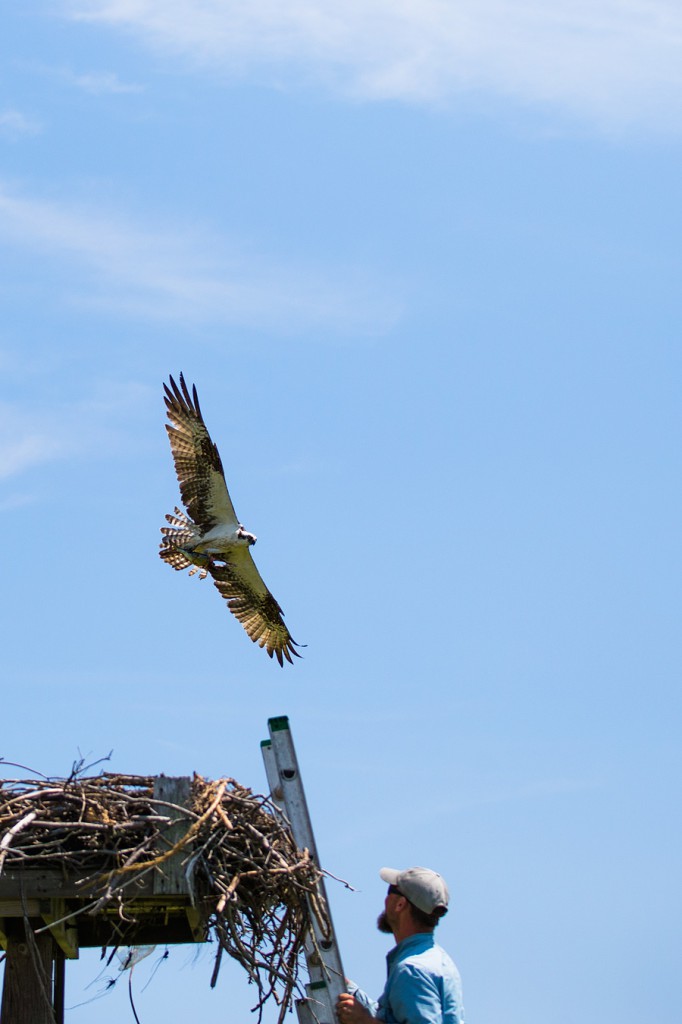
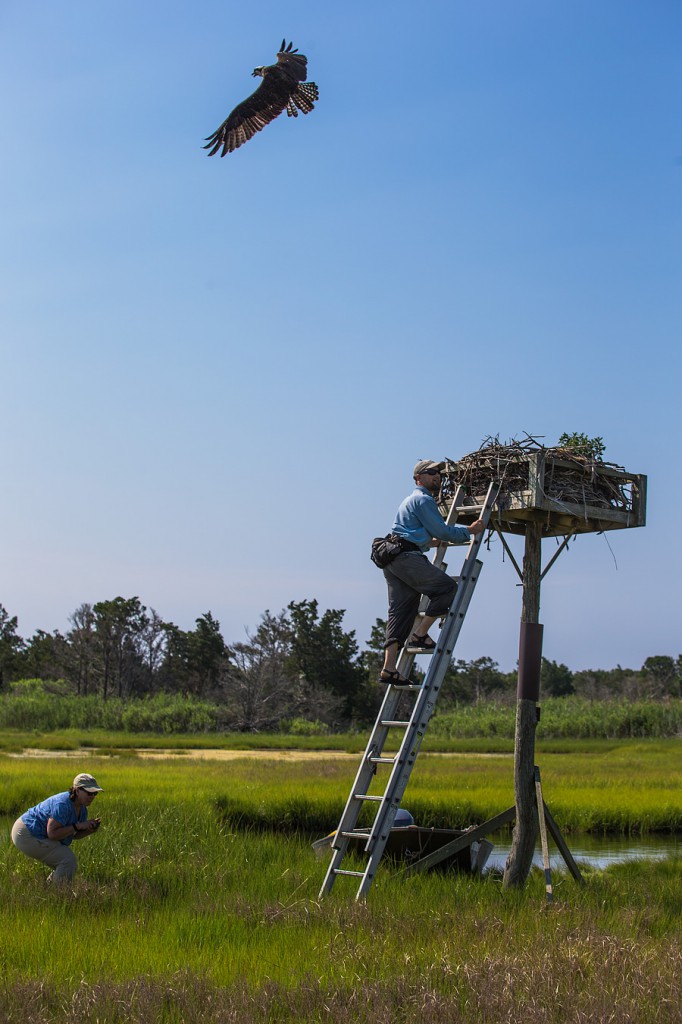

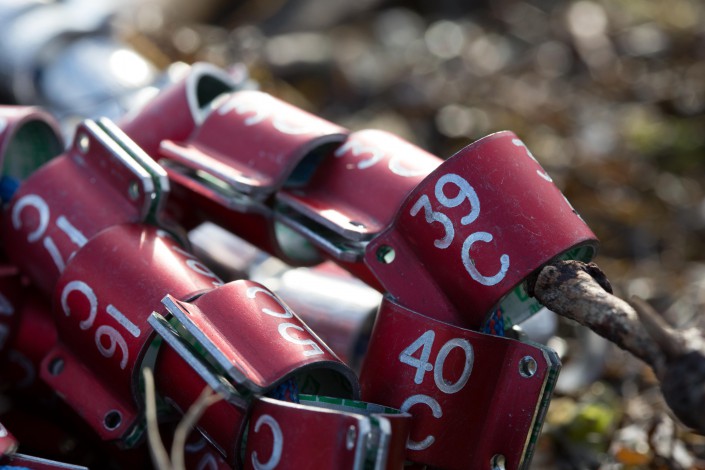

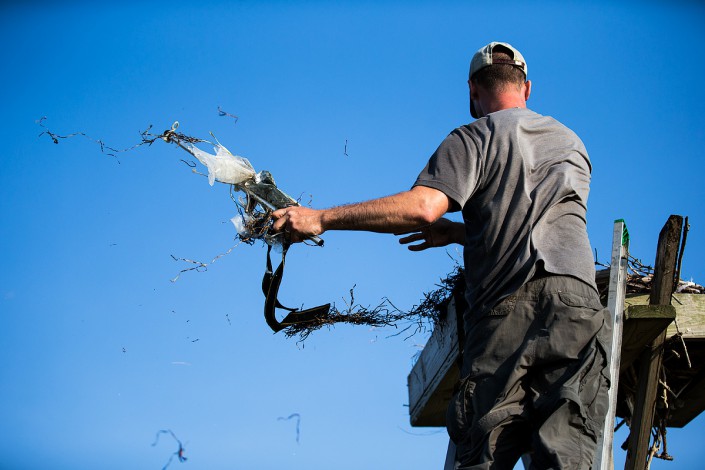

by Ben Wurst, Habitat Program Manager
Surveys of nesting osprey have ended for 2012. Each year volunteers, state biologist and CWF staff complete nesting surveys of ospreys. These “osprey banders” complete “ground surveys” (referred to as ground surveys because they are surveying nests by land/sea, not by helicopter) that cover around 70% of the state population. The surveys are meant to keep tabs on the state population and data collected from the surveys are used to determine the health of the population. Young are also banded for future tracking. Next year a state wide aerial survey will be conducted; the last aerial survey was in 2009 where 486 nesting pairs were found. We won’t know the total size of the population until then. Nesting success is mixed this year and is highly variable by different regions, mainly because of severe weather.
I never heard of a “derecho” until this summer. According to Wikipedia it is “a widespread, long-lived, straight-line windstorm that is associated with a fast-moving band of severe thunderstorms.” A derecho hit Cumberland, Salem, Atlantic & southern Ocean County in the early morning hours on June 30th, right in the middle of the nesting season for ospreys. Weather plays a significant factor in the success of nesting ospreys. They nest in open areas, which makes them vulnerable to high winds and severe weather, and since they primarily feed on fish, water clarity affects foraging success.
“In South Jersey, Atlantic City Electric reported that 206,000 customers lost power from downed trees. Most of the outages were in Atlantic County, which prompted a county-wide state of emergency. Near Atlantic City, a boater died while trying to bring his vessel ashore. Officials believed that lightning struck a 104-year-old church in Longport and caused a fire that damaged the building. An elderly couple was killed when a tree fell on their house. In Vineland, damage was preliminarily estimated at $125 million. On July 19th, 2012, President Barack Obama declared three counties in New Jersey (Atlantic, Cumberland, and Salem) federal disaster areas. This assured disaster relief through federal assistance to local and state governments and some non-profit organizations.” (from Wikipedia.com) I also know that two people were killed while sleeping in a tent at Parvin State Park.

At this time most young were between 2-3 weeks old, with some a little older and some younger. All young are very vulnerable to severe weather, especially when wind gusts reach 70-100 mph, they can be easily blown from their nests and if not retrieved quickly could become food for ground predators or washed away with the tide. Winds gusted to 81 mph in Tuckerton, 74 mph in Absecon (Reported by the NJ State Climatologist Dr. David A. Robinson). In three areas that I survey (Absecon, Mullica River, & Little Egg Harbor) many young were either lost or blown from their nests and found dead or live on the marsh. In Absecon 9 of the 22 young produced had been lost or found dead on the marsh as a result of the storm. At a couple other nests to the north a few young were found on the ground shortly after the storm. Off of Great Bay Blvd. many nests that had young before the storm had lost them. One of our volunteers reported that many nests in Ventnor that were previously occupied had no young after the storm.
We can only hope that severe weather like this will not occur during the middle of the osprey nesting season again, but with a warmer climate these might become commonplace in New Jersey. One thing that we might consider is to take a long look at our current design for nesting platforms and look to see if we can make changes to allow for a deeper nest bowl. More of a problem is that some ospreys do not build substantial nests and use little sticks and branches, while others build large nests that are not easily blown away with the wind.
by Ben Wurst, Habitat Program Manager

The New Jersey Osprey Project began after the osprey was listed as an endangered species in 1973. In April 1974 an aerial survey was conducted to count the number of active osprey nests. The survey was conducted from Toms River to Atlantic City. The results were grim. Only five active nests were found. 10 years earlier there were over 50 in that same area. On all of Barnegat Bay in 1974 there was only one active osprey nest.
The heavy use of DDT in the 1950’s and 60’s was the main culprit in the decline of ospreys by affecting their ability to reproduce. When used in marine environments it was quickly absorbed by organisms and soils. It accumulated in the food web and because it was fat soluble it bioacummulated in predators, especially birds of prey. In short, it caused the thinning of eggshells which often broke under the weight of the incubating female. This threat, along with habitat loss and persecution caused the population to become almost extirpated from the state.
Continue reading “Early recovery efforts pay off”
by Ben Wurst, Habitat Program Manager

It’s hard to believe that in another 6-7 weeks ospreys will be back in New Jersey and ready to begin another nesting season. Over the next few weeks we’ll be busy making repairs to existing nests, moving platforms to more suitable locations, and installing new nests to replace old derelict platforms. We maintain a huge portion of the available nest platforms along the coast and do so with no state funding! All of our funding comes from private donations from individuals, foundations, or grants. Since our osprey project began in 2006, we have installed more than 100 nesting platforms throughout New Jersey. What’s new? This winter we have plans to install three new structures in Bayonne with local high school students. This will be the furthest north that we have ever worked with ospreys. It’s a new and exciting endeavor for CWF. If you enjoy viewing ospreys during your visits to coastal areas of New Jersey during the summer, please consider making a donation today by sponsoring the placement of a platform or by adopting an existing platform.
by Ben Wurst, Habitat Program Manager
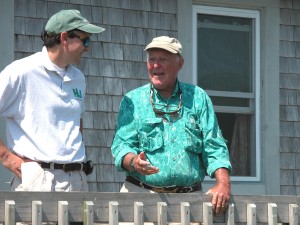
Last year we installed or relocated a total of 17 osprey nesting platforms. This year we installed or moved another 21. In 2011 there were 25 new pairs, some of which, that nested on these new platforms. This year was another record setting year for ospreys in New Jersey. We recorded an average of 2.07 young per active nest, a new record. We last documented the size of population at 486 nesting pairs in 2009 when we conducted a statewide census. We now believe that the state population has met recovery goals (of more than 500 nesting pairs) that were set after DDT and habitat loss decimated the population by upwards of 90%. We aren’t the only organization who has helped with the recovery of ospreys. We credit the hard work of biologists with the Endangered and Nongame Species Program in the 1970-present who worked tirelessly to help the population rebound. To name a few, former Deputy Chief of ENSP, Pete McLain; former Director of NJFW, Marty McHugh; former Chief of ENSP Larry Niles, current Chief of ENSP, Dave Jenkins; current Director of NJFW, Dave Chanda; and Supervising Zoologist Kathy Clark who has worked to protect ospreys over her entire 20+ year career with ENSP.
We can also credit the recovery efforts to local environmental and water-quality improvements, like the Barnegat Bay Initiative and restoration of the Meadowlands, and by the grass-roots efforts by concerned citizens and groups who have helped provide nesting platforms to accommodate their population growth.
In the next week ENSP and CWF will be releasing the 2011 Osprey Project Newsletter which summarizes the entire nesting season survey results. In the meantime, check out the video below of myself and two friends who volunteered to help me move a nesting platform on southern Barnegat Bay in late 2010. note: I usually have more than 3 people who assist me when installing an osprey platform. As they say “the more, the merrier…”
written by Maureen Barrett, CWF volunteer/donor/wildlife enthusiast/educator
With wind speeds clocked at 91-92 mph, the osprey nest behind my house didn’t stand a chance! On Tuesday, July 19th around 8:00 P.M., a thunderstorm came barreling into Fortescue from the northeast. It was a wicked storm with thunder, lightning, and even hail. The wind was so strong that my purple martin housing was being blown around like it was a stalk of phragmites. The adult osprey held their positions on the perching supports of the platform for as long as they could, but soon jumped ship. By that time, the pole for the martin house broke and I couldn’t even see the osprey platform through the rain.
After the storm, some moonlight allowed me to see the silhouette of the osprey platform. It was still standing. But I couldn’t see any nesting material inside; it looked empty. I made an attempt to walk through the marsh to get a closer look, but I thought it would be wise to wait until first light. So I waited for the sun to rise.

By 5:00 A.M., my suspicions were confirmed. There was not one piece of nesting material on the platform. Fortunately the adults survived the storm and were once again perched on the platform supports, but the nest and chick were gone. The high winds blew everything off the platform. I quickly put my boots on and walked out on the marsh. I was surprised how relatively easy it was to get to the platform after getting a few inches of rain the night before. There was only one very small ditch I had to cross. I soon found the pile of nesting material and on the edge of the pile was a clump of wet feathers. It looked like the storm had taken the chick’s life. But then I saw some movement! It had survived the storm, the fall, and an evening on the ground!
This being my first experience with such an ordeal, I called my friend Bill Miller who lives up the street. (You know who your friends are when you call them before 6:00 A.M. for a favor!) He brought down a ladder and a piece of plywood. We went back on the marsh, dried the chick with a towel, and put it back on the platform. Within a few minutes, the adults returned to the platform to see their chick back in the nest.
Two other nests in Fortescue were also destroyed by the storm. Later that day, Brian Johnson of the Natural Land Trust’s Glades Wildlife Refuge had to place a foster chick in my nest. This chick’s nest was in a tree and totally destroyed. Both chicks are getting along just fine and being fed by the adults.